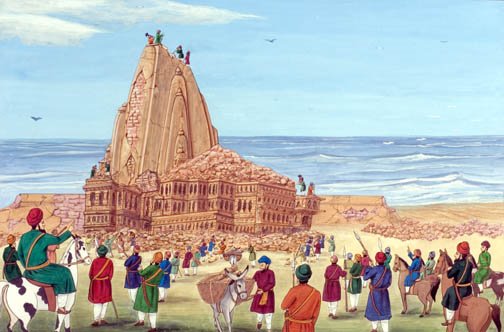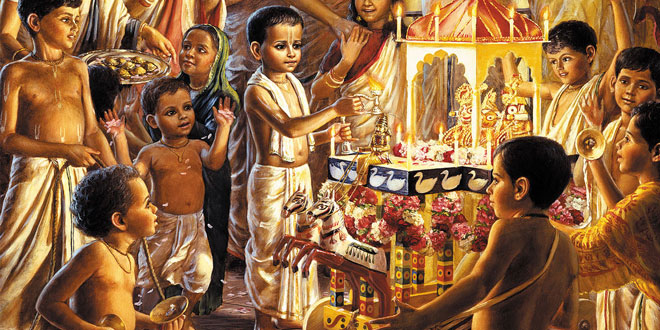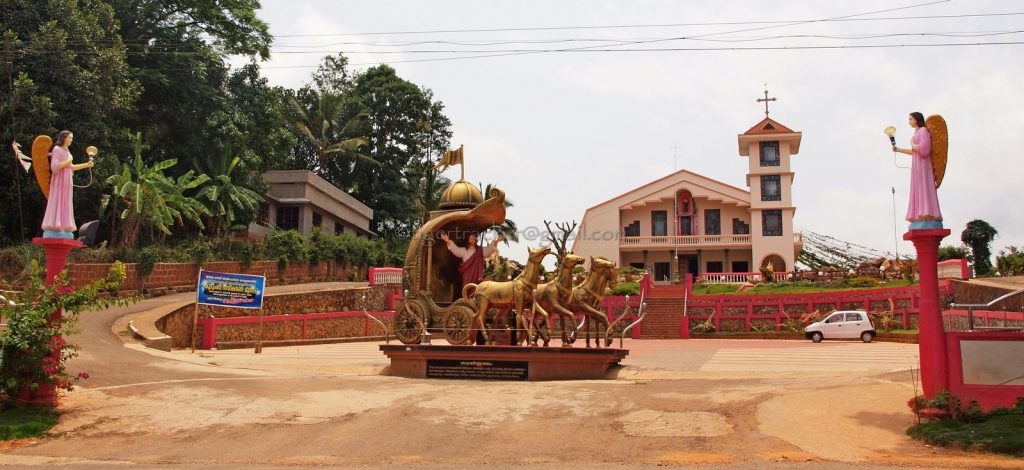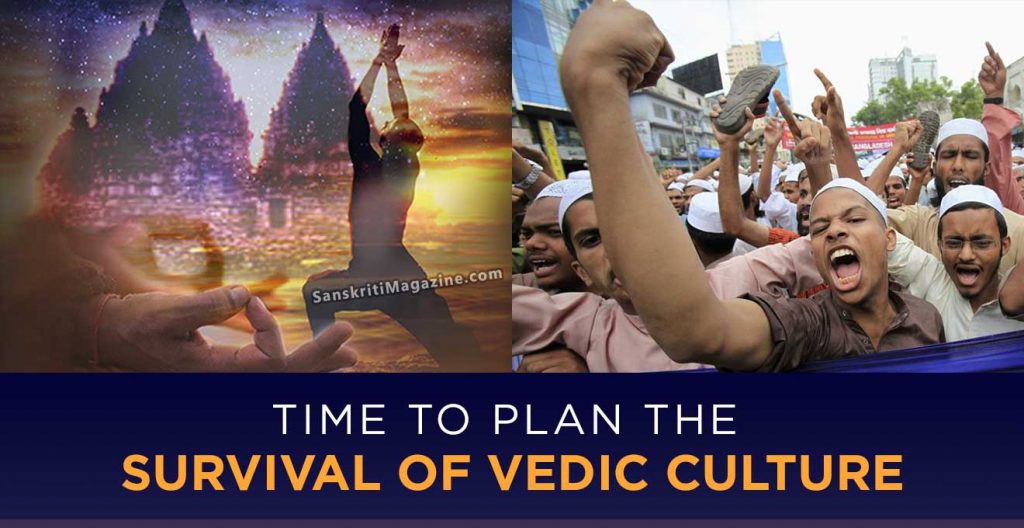By Stephen Knapp
From the information that we have, we can fairly safely say that since Islam existed only from 622 CE, the majority of Muslims in India, Pakistan and Bangladesh today are descendants of captured, mistreated, or distressed Hindus.
A blatant example of this is the story of one Nazir Ali, which appeared in a Letter to the Editor in the Weekly Organizer (New Delhi, July 13, 1997). Nazir Ali was a Muslim man who had settled in the United States. He and his family had been away from India for a long time and invited his grandfather from Mehrauli (New Delhi) to come to America to get acquainted with his grandchildren. After the grandfather’s arrival, the children would gather around him in the evening for a nostalgic chat.
On one such occasion Nazir Ali asked his grandfather as to why the male elders in their family always wore dhotis (the traditional Indian Hindu dress) though they were Muslims. Thereupon, to Nazir Ali’s great consternation and distress, the old man broke into uncontrollable sobs and tears, and stuttered out the words, “Beta, how should I tell you? Ours was a Brahmin family owning a Hanuman temple in Merauli. But 400 years ago as victims of an invading Muslim army some of our ancestors were slain while some others with sword points pressed on their throats agreed willy-nilly to survive only as Muslims. But to keep alive the memory of our Hindu ancestry, our elders made it a rule that all males should invariably stick to the dhoti.”
Hearing the heart-rending account, Nazir Ali was in a great fix. Like Nazir Ali’s ancestors, a number of so-called Muslims continue to tenaciously stick to tender tokens of their Hindu ancestry, such as imprinting Ganesh on their wedding invitations, retaining a tiny Bhagavadgita inside the Koran, calling in a Hindu priest to apply a bindi to a bride, and lisping the name of Lord Rama while doing the Namaz (Muslim prayers). Thus, Muslims in India are descendants of Hindus, some of whom still hold dear to their hearts their ancient Vedic heritage. In this same line of thought, we can also point out that most historic buildings and townships credited to Muslims are captured properties that were once Hindu. In this way, it is time to recognize the glory of Vedic India and work to preserve it and keep it the home of Vedic culture.

We must realize, however, there is much that is working against this from happening. The deterioration of Indian Vedic culture is rapidly taking place. One thing that is very prominent in causing the disintegration of Vedic culture is the so-called “secular” nature of the Indian government leaders over the past several decades. Secular should mean democratic, in which every religion is protected. However, for the sake of getting votes and approval, many politicians have pandered to the demands of Muslims, promoting Islamic interests in India at the expense of the Hindus, Sikhs, Jains, and others. They have carved up Malabar district just to create the Muslim majority district of Malappuram. There are states in which the whole school gets half-a-day off on Fridays to offer Namaz, even if only two students in a class are Muslim. Yet, for the real progress of Muslims, which depends on education and modernization, they have done nothing.
Other ways that Vedic principles are being eroded away can be recognized in the following example: Article 48 of the Indian Constitution states that, “The state shall take steps for preserving and improving the breeds, and prohibiting the slaughter of cows and calves and other milch and drought cattle.” This should mean a complete ban on the slaughter of cows, bulls, and calves. Protecting and preserving cows is definitely a Vedic principle. However, the courts have interpreted this article to mean that aged and disabled bulls can be slaughtered. Taking advantage of this loophole, cattle are maimed and “certified” as disabled and then slaughtered. In the years from 1976 to 1992, beef sale has gone up from 70,000 tons to over 1,100,000 tons. This not only goes against the principles of India and Vedic culture, but it makes cows more scarce and milk expensive.

Article 44 of the Indian Constitution says: “The state shall endeavor to secure for the citizens a uniform civil code throughout the territory of India.” This would include a uniform ban on polygamy, but the Muslims want to be free, and have been, from following such a law. Thus, Muslim men can easily have up to four wives. Such implementation of the law would provide a greater security for Muslim womanhood, and also prevent irresponsible Hindu males from converting to Islam simply to have more than one wife.
To show even further how Congress-trained politicians, though Hindus themselves, have been following the suicidal policy of curbing Hindu rights and pampering all kinds of minorities by conferring on them special privileges can be seen in a special report. This was written by Dr. Edmund Weber and presented at the fifth International Hindu Conference in Germany in 1992. Some of the findings are: “The religious minority of 100,000 Ladakhi Buddhists are officially marked as Hindus and they, in contrast to the over 100,000,000 Indian Muslims, have no right to follow their traditional marriage law.”
“The pseudo-secularism of India is not even today ready to fulfill the demands of the Hindu democrats to introduce the same civil code for all their citizens. This mentality has only the mind to maintain privileges of powerful groups.
“The pseudo-secularism discriminates particularly the Hindus in the educational area. The education bills are valid only for them, while the minorities constituted by the state are over privileged, e.g. they are exempted from all those rules.
“The Tamilnadu Education Acts do show in a special way (that a) Hindu institution must get permission before starting a school. Prior permission is not required in the case of minority [Muslim or Christian] schools.
“Hindu institutions must adopt communal representation for appointing teachers, i.e. Muslims, Christians, etc., but a Minority school need not (follow) that rule.” This means that Muslim or Christian schools do not have to provide any Hindu teachers, although the community may be primarily Hindu. This is how the Vedic culture is disappearing. The most efficient way to take over a country or change the viewpoint of a population is to take over all forms of communication and the educational systems. This is the legal right that has been given by the politicians to the minority groups in India.
The report goes on: “While every Hindu school must have a school committee including teachers, Minority schools need not have such committees.
“The most dangerous kind of blockade against the renewal of Hinduism is that the great monasteries and temples in India were forced to have temple committees… while pseudo secularism, out of political opportunism, grants non-Hindu religions full autonomy (over) their holy buildings and places; e.g. in Kerala a non-Hindu was deliberately (made a) member of the Guruvayoor temple committee. The nomination was canceled only after a vehement protest and the non-Hindu member was replaced by a Harijan [Hindu].
“Those so-called secular governments who do not dare to interfere in any manner in the management of churches, maqbaras, mazars and mosques [of the minority groups] make unjustified and most objectionable and unethical evil attempts to take over control of Hindu Mutts and Mandirs [temples].”
This is further explained by Dr. Gopalacharya in his book, World-Wide Hindu Culture (p.v), “The anti-Brahmin movement started by the cunning policy of the Britishers was followed by the post independent Indian secular Governments, which made laws to uproot (general Hindu society) by the tenancy acts enabling the Government to make the temples, maths, and religious educational institutions lose their lands and other resources for their maintenance. For want of resources, the above institutions became defunct. The greatest tragedy was that these laws were not imposed on non-Hindu religious institutions. As their properties of the religious institutions were given special facilities, instead to get lump votes, the urgent need of the majority community is to get all the unjust laws repealed and choose only those which do justice to all the communities without partiality.”

This is very important, otherwise many of these problems that we have mentioned will only increase. You find these problems today as when you have colleges run by the Catholic church in India who penalize you with a fine if you speak your native tongue on their campus. They want English only because the vernacular languages are associated with heathen deities. Bible and Christian prayers are mandatory at the start of class is such schools, yet secular government ministers are known to have objected to including Indianized moral and spiritual education in regular Indian schools. The Bible can be taught in Christian schools, but to impart moral codes based on the Upanishads or Puranas in regular Indian schools becomes highly objectionable.
The same thing goes on with the Muslim schools, only Urdu is spoken, not native local languages. Thus, such students grow up knowing Urdu, which assists in directing them to become Muslim converts, if they are not already Muslim. By also encouraging Muslim principles throughout India, like allowing Muslim men to have four wives and easy divorces to remarry and have more children, and have the government pick up the tab for maintaining them, is a way to break down Vedic society in India and make it an extension of Pakistan.
This same bias is viewed in other ways as well. Taxes are collected from Hindu charities but none from Muslim or Christian religious properties, which are tax-free. Even in West Bengal, the Communist-run government admits being anti-Hindu and recently pulled down a Shiva temple. Other government ministers have halted Vedic yajnas, fire rituals, because they considered it a waste of using ghee. Yet, in order to show their secular tendency, the same ministers participate in the Muslim Bakrid festival when many milk-producing cows are slaughtered in the name of religious tenets. Does this make sense? This is outrageous.
Another example is that in the district of Kanya Kumari in South India, churches can build large statues of Jesus, but the government pulled down a large image of Hanuman. Does this make sense? What kind of favortism is this?
Though Christian churches and Islamic mosques cannot be touched, Vedic temples are often taken over to be managed by the government. Then they often appoint members to the board who may be atheists, Communists, or of different faiths who care little for the well-being of the Vedic temple. What is worse, they may simply run the temple down, or steal funds meant for maintaining the temple, or take land and jewels of the Deity that were lovingly donated by devotees over many centuries. It is in this way that secularism in India works for upholding Christianity and Islam at the expense of Hinduism.

Even now the wealthy classes in India often prefer to send their children to schools where English is taught. Unfortunately, many of the English schools are operated by Christians, in which Christian tenets are expounded and any regard for Vedic culture and history is ignored. Thus, Indian children of the wealthy and influential classes grow up with little regard for their own culture. Meanwhile, children of Muslim countries and schools are taught strong respect for the Koran and Islamic principles. Thus, Vedic culture is being lost even willingly in India.
All Hindus and followers of the Vedic culture had better understand the meaning of the above information and begin to demand changes in their government in India. They must remove from power all who talk of secularism at the expense of, or to kill, Hinduism. Annie Besant once said that India and Hinduism are always connected: One cannot be without the other. India is India only with the presence of the Vedic culture. If that is not maintained, then the Vedic motherland of India will no longer be the motherland. And then Hindus may wake up one day to find that they no longer have a home.
Although it will take much time to recover from the great degradations and deterioration that have occurred in Indian society from the time of Vedic reign, and it may never fully recover, nonetheless it is time to bring back the united, peaceful, purposeful, and pious Vedic culture. The first thing to do is for Hindus to arm themselves with knowledge about their great World Vedic Heritage. India should make sure that it is a place where the practicality of Vedic culture is permanently preserved. This culture, properly called “Sanatana-Dharma,” which is the everlasting social order based on the eternal nature of the soul refers to the righteous, enlightened order meant for the impartial and affectionate enlistment of every individual.
In order for this to take place, the 82% Hindu population of India must no longer be a timid people who are afraid to give up their neutralist stand, avoidance of proselytizing, or defending themselves. It is time to recognize the elements that are working to stifle and push down Vedic culture. To keeo itself from certain death, Hinduism, Sanatana-Dharma, those of the Vedic culture, must once again enter a phase of self-assertion and subdue the various forms of intimidation and discrimination in order to assure that India remains the home of Vedic society.
In India, such governmental discrimination should be stopped, and everyone should follow one set of laws, not that minorities have the liberty to set their own laws at the disadvantage of the majority of Hindus. India has already been broken into parts, such as Bangladesh and Pakistan, for the sake of separatist. How much more does it need to be broken up, or broken down, in order to satisfy or calm the minority non-Hindus in Indian who refuse to change their ways? It’s time to draw the limits and set the standard if we are intent on the survival of Vedic culture. And that to change is NOW!











